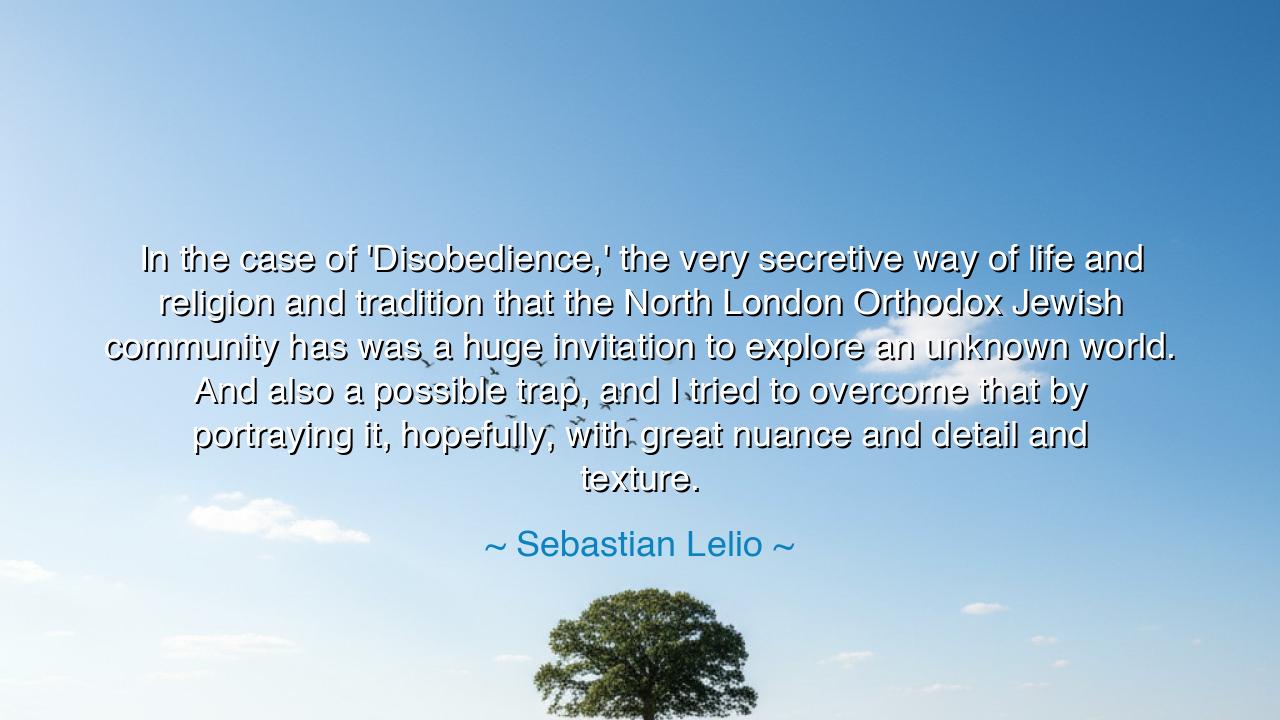
In the case of 'Disobedience,' the very secretive way of life and
In the case of 'Disobedience,' the very secretive way of life and religion and tradition that the North London Orthodox Jewish community has was a huge invitation to explore an unknown world. And also a possible trap, and I tried to overcome that by portraying it, hopefully, with great nuance and detail and texture.






Sebastián Lelio, the storyteller of hidden worlds, once declared: “In the case of Disobedience, the very secretive way of life and religion and tradition that the North London Orthodox Jewish community has was a huge invitation to explore an unknown world. And also a possible trap, and I tried to overcome that by portraying it, hopefully, with great nuance and detail and texture.” In this confession, he reveals the burden and the blessing of the artist: to enter into the lives of others with curiosity, respect, and courage, while resisting the snares of simplification and judgment. For when one approaches a secretive way of life, it is easy to stumble into caricature or distortion—but the noble path is to portray it with honesty, nuance, detail, and texture.
The ancients knew the danger of misrepresenting another people’s customs. Herodotus, called the Father of History, traveled among the Persians, the Egyptians, and the Scythians, recording their ways. Some mocked his writings as strange, yet his great contribution was that he did not dismiss what he did not understand—he preserved it, even if imperfectly. Lelio stands in that same tradition. The invitation to explore an unknown world is not a license to dominate it, but a sacred responsibility to reflect its truth as faithfully as an outsider can.
Yet he admits, too, the shadow: that such work can be a trap. For when we gaze upon what is hidden, our own prejudices creep in. The foreign may seem exotic or oppressive, romantic or cruel, depending on the lens we carry. Many empires of old misrepresented the religion and traditions of conquered peoples, reducing them to superstition or barbarism in order to justify domination. Lelio, with humility, confesses this danger and declares his intent: to overcome it by seeking detail and texture, to let the humanity of the community speak, rather than imposing upon it the heavy hand of judgment.
Consider the story of Akira Kurosawa, the Japanese master who brought the samurai world to global audiences. He, too, faced the task of portraying an insular culture. With care, he showed their honor, their contradictions, their violence, and their beauty. In films like Seven Samurai, he painted his people not as flat archetypes but as living beings. In the same way, Lelio, in Disobedience, sought to depict the Orthodox Jewish community neither as saintly nor villainous, but as complex, with rituals, faith, and human longings intertwined.
The deeper meaning of Lelio’s words is that art must become a bridge. The artist enters into mystery and returns with an image that allows others to see what they could not otherwise witness. But if the bridge is built poorly, it collapses, and the audience walks away with falsehood instead of understanding. To show nuance is to weave a bridge strong enough to carry truth, to give outsiders a glimpse of another’s life without robbing that life of its dignity.
The lesson for us is clear: when you encounter a way of life not your own—whether in art, in travel, or in daily encounters—approach it with reverence. Do not rush to judge, nor dismiss it as strange. Instead, look for detail, nuance, and texture. Ask questions not to expose but to understand. For in every tradition, no matter how secretive or distant, there are stories of humanity—love, fear, loyalty, and hope—that mirror your own.
Practical actions flow from this. Read widely beyond your own culture. When speaking of others, resist sweeping statements—seek instead the texture of individual lives. Support art that portrays communities with honesty rather than stereotype. And when you create—whether in writing, painting, or even daily conversation—strive to reveal the human depth within what is hidden.
O seeker, remember Sebastián Lelio’s wisdom: the invitation to explore an unknown world is also a test. If you take it lightly, you fall into the trap of distortion. But if you walk humbly, with eyes open to detail and heart open to nuance, then you will honor both truth and humanity. For the task of the artist, and of every soul, is not to simplify the mystery of others, but to illuminate it with reverence.






AAdministratorAdministrator
Welcome, honored guests. Please leave a comment, we will respond soon